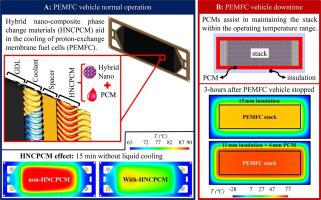当前位置:
X-MOL 学术
›
Appl. Therm. Eng.
›
论文详情
Our official English website, www.x-mol.net, welcomes your
feedback! (Note: you will need to create a separate account there.)
Advancing heat management in proton-exchange membrane fuel cells through hybrid nano-composite phase change materials
Applied Thermal Engineering ( IF 6.1 ) Pub Date : 2024-01-04 , DOI: 10.1016/j.applthermaleng.2023.122323 Iman Sarani , Mingxi Ji , Zhiming Bao , Wenming Huo , Bowen Wang , Yan Yin , Qing Du , Kui Jiao
Applied Thermal Engineering ( IF 6.1 ) Pub Date : 2024-01-04 , DOI: 10.1016/j.applthermaleng.2023.122323 Iman Sarani , Mingxi Ji , Zhiming Bao , Wenming Huo , Bowen Wang , Yan Yin , Qing Du , Kui Jiao

|
Heat management challenges in proton-exchange membrane fuel cells (PEMFC) leads to performance degradation, particularly during operational fluctuations and vehicle downtime. This study examines the use of Nano-additive phase change materials (PCMs) as an innovative approach to thermal management in PEMFCs. It addresses a research gap, as PCMs' advantages in batteries and electronics are well-known, but their application in PEMFCs remained relatively unexplored. Hence, using the ChtMultiRegionFoam solver from OpenFOAM, two heat transfer aspects in PEMFCs are studied. The first examines PEMFC cooling under normal conditions, combining liquid cooling with a hybrid Nano-composite phase change material (HNCPCM). The results indicate the HNCPCM cools the PEMFC for 11 min before reaching saturation, after which liquid cooling starts. Moreover, with HNCPCM, the PEMFC's thermal efficiency and temperature uniformity enhance by 7.04 % and 39.76 %, respectively. Therefore, the HNCPCM contributes to cooling as the temperature and voltage fluctuate under real conditions. The second aspect evaluates PCM and insulation to maintain the PEMFC stack's operating temperature range (OTR) during downtime. Using 4 mm PCM and 11 mm insulation, the stack stays within the OTR for nearly 4 h, extending the OTR duration by 49.2 %. Consequently, the waste energy stored by PCM ensures the stack remains within the OTR, averting performance degradation upon restart.
中文翻译:

通过混合纳米复合相变材料推进质子交换膜燃料电池的热管理
质子交换膜燃料电池 (PEMFC) 的热管理挑战会导致性能下降,特别是在运行波动和车辆停机期间。本研究探讨了纳米添加剂相变材料 (PCM) 作为质子交换膜燃料电池 (PEMFC) 热管理创新方法的使用。它填补了研究空白,因为相变材料在电池和电子学方面的优势众所周知,但它们在质子交换膜燃料电池中的应用仍然相对未经探索。因此,使用 OpenFOAM 的 ChtMultiRegionFoam 求解器,研究了 PEMFC 中的两个传热方面。第一个检查正常条件下的 PEMFC 冷却,将液体冷却与混合纳米复合相变材料 (HNCPCM) 相结合。结果表明,HNCPCM 在达到饱和之前将 PEMFC 冷却 11 分钟,然后开始液体冷却。此外,采用HNCPCM后,PEMFC的热效率和温度均匀性分别提高了7.04%和39.76%。因此,当实际条件下温度和电压波动时,HNCPCM 有助于冷却。第二个方面评估 PCM 和绝缘层,以在停机期间维持 PEMFC 堆栈的工作温度范围 (OTR)。使用 4 毫米 PCM 和 11 毫米绝缘材料,电池堆在 OTR 内停留近 4 小时,将 OTR 持续时间延长 49.2%。因此,PCM 存储的废能可确保堆栈保持在 OTR 内,从而避免重启时性能下降。
更新日期:2024-01-04
中文翻译:

通过混合纳米复合相变材料推进质子交换膜燃料电池的热管理
质子交换膜燃料电池 (PEMFC) 的热管理挑战会导致性能下降,特别是在运行波动和车辆停机期间。本研究探讨了纳米添加剂相变材料 (PCM) 作为质子交换膜燃料电池 (PEMFC) 热管理创新方法的使用。它填补了研究空白,因为相变材料在电池和电子学方面的优势众所周知,但它们在质子交换膜燃料电池中的应用仍然相对未经探索。因此,使用 OpenFOAM 的 ChtMultiRegionFoam 求解器,研究了 PEMFC 中的两个传热方面。第一个检查正常条件下的 PEMFC 冷却,将液体冷却与混合纳米复合相变材料 (HNCPCM) 相结合。结果表明,HNCPCM 在达到饱和之前将 PEMFC 冷却 11 分钟,然后开始液体冷却。此外,采用HNCPCM后,PEMFC的热效率和温度均匀性分别提高了7.04%和39.76%。因此,当实际条件下温度和电压波动时,HNCPCM 有助于冷却。第二个方面评估 PCM 和绝缘层,以在停机期间维持 PEMFC 堆栈的工作温度范围 (OTR)。使用 4 毫米 PCM 和 11 毫米绝缘材料,电池堆在 OTR 内停留近 4 小时,将 OTR 持续时间延长 49.2%。因此,PCM 存储的废能可确保堆栈保持在 OTR 内,从而避免重启时性能下降。


















































 京公网安备 11010802027423号
京公网安备 11010802027423号